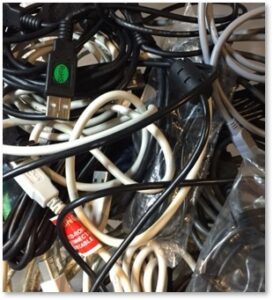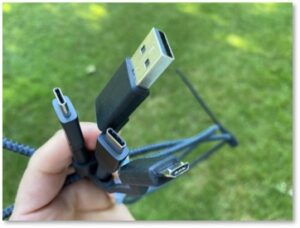 Most of us have a drawer full of charging cables and wires for connecting electronic devices. Heck, some of us have a whole box of them.
Most of us have a drawer full of charging cables and wires for connecting electronic devices. Heck, some of us have a whole box of them.
We take it for granted that each manufacturer will use dedicated cables with specific connectors, none of which will work with any other device. Tech companies have trained us to think this way, although it does not work in our favor.
Think about it. What if every car had a different shape of gas tank opening. A gas station would need multiple hose nozzles to fill all the tanks. Would that make sense?
Confusing the Customer
To make things worse, the same manufacturer will change the connectors they use for different devices or even for different versions of the same device. This makes for confusion as we, the customers, lose track of which cable goes with which device.
To make things worse, he company may not put their name or logo on the charging cable so you have to rely on trial-and-error to find the right one. Sure, we can test it by trying to plug in the connector but that’s like trying to find the right plastic lid for a storage container in our kitchens. Somehow, they all shift and change so that we can never find what we need when we need it.
And all the while, those cables and wires and connectors pile up.
Charging the Microphones
This happened to me on Tuesday, when I tried to charge one of my two microphones. I opened the desk drawer where I keep my cords and chargers and searched for the charging cable for either one. No luck.
Now, I keep all my cables in that drawer so they were unlikely to have wandered somewhere else on my desk. Of course, I had everything I needed for the fitness band I no longer use because I replaced it with a better one.
When my search turned up fruitless, I tried a cable from a different device (white) to charge up one of the mics (black) and it worked. Hooray!
But it only worked with that mic, not the other one. Boo!
Why So Many Connectors?
I figured out a workaround. Good for me. But the real issue is why there are so many different cables and connectors for a variety of devices. Why can’t we have a universal charging cable? Or consistent connectors?
We can buy one, for course. Just Google “universal charging cable” and you will find a variety of options. It’s like purchasing a universal remote control for all your media devices. Or buying a set of electrical plugs for every country in Europe. You can do it, but it just means adding more cables to the existing collection.
Poor Customer Satisfaction
This shouldn’t be necessary, however. Manufacturers need to think about customer satisfaction. Sure, a dedicated cable and connector lock you in to that company—sort of. If I have to order a new charging cable for the second mic, that means money for the company, right?
NOTE: I have my eye on the Nomad Universal-C Cable but I haven’t finished my research.
In the long run, however, a new power cord or charging cable won’t increase their profitability. Universal charging cables would improve customer satisfaction, though. No one ever got rich by making things difficult for their customers–except, perhaps, for Microsoft.
Imagine if you could charge any device from any cable in in your cluttered drawer. Wouldn’t that be great?
FOLLOW UP: The EU has announced a mandate that will require all new portable devices like smartphones, earbuds and wireless keyboards to use a common charger by 2024. The same rules will apply to new laptops in 2026. As the article states, “Although the law will be enforced throughout Europe, it may affect consumers worldwide. That’s because it will most likely be costly for tech companies to make products with different charging technology only for European countries.”
This is good news for all of us.

